MGT602 Business Decision Analytics: Assessment 3 Report on Diversity
VerifiedAdded on 2022/08/20
|18
|3188
|13
Report
AI Summary
This report provides a comprehensive analysis of business decision-making, focusing on a case study at Torrens University. It explores the challenges of managing a diverse workforce and the application of various decision-making tools, including intuition, decision tree analysis, and Simon's normative model, to address these challenges. The report details the data collection methods, including both primary and secondary sources, and presents the findings from a survey of Torrens University employees regarding diversity issues. The analysis reveals key problems such as cultural insensitivity, gender and age discrimination, and lack of cooperation among colleagues. The report also presents the survey results in graphical form, highlighting the employees' perspectives on these issues. Based on the findings, the report recommends providing training to staff members, improving organizational culture, and eliminating discrimination to effectively manage diversity within the organization. The report concludes with a discussion of ethical considerations and the importance of reducing bias in the decision-making process.
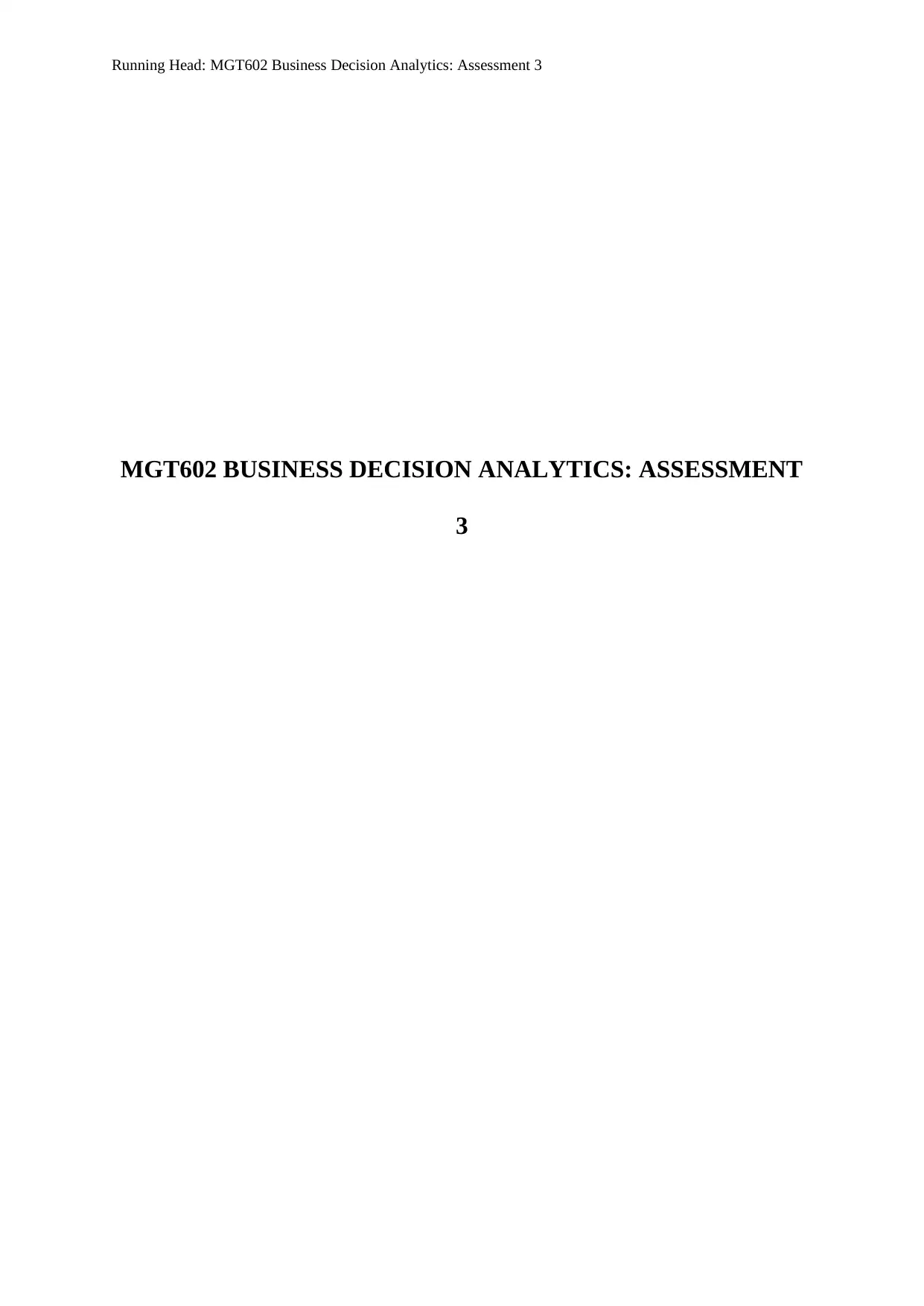
Running Head: MGT602 Business Decision Analytics: Assessment 3
MGT602 BUSINESS DECISION ANALYTICS: ASSESSMENT
3
MGT602 BUSINESS DECISION ANALYTICS: ASSESSMENT
3
Paraphrase This Document
Need a fresh take? Get an instant paraphrase of this document with our AI Paraphraser
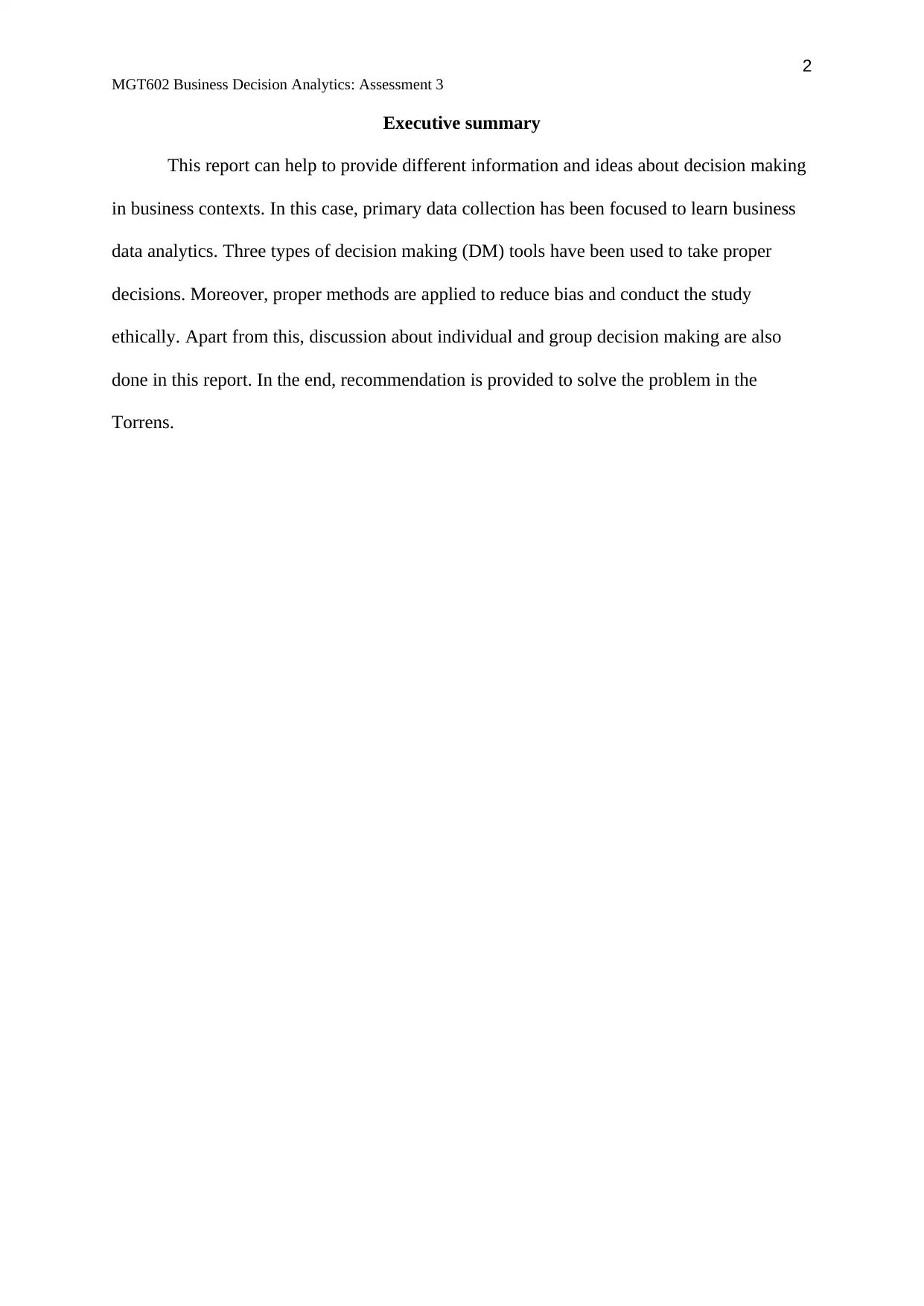
2
MGT602 Business Decision Analytics: Assessment 3
Executive summary
This report can help to provide different information and ideas about decision making
in business contexts. In this case, primary data collection has been focused to learn business
data analytics. Three types of decision making (DM) tools have been used to take proper
decisions. Moreover, proper methods are applied to reduce bias and conduct the study
ethically. Apart from this, discussion about individual and group decision making are also
done in this report. In the end, recommendation is provided to solve the problem in the
Torrens.
MGT602 Business Decision Analytics: Assessment 3
Executive summary
This report can help to provide different information and ideas about decision making
in business contexts. In this case, primary data collection has been focused to learn business
data analytics. Three types of decision making (DM) tools have been used to take proper
decisions. Moreover, proper methods are applied to reduce bias and conduct the study
ethically. Apart from this, discussion about individual and group decision making are also
done in this report. In the end, recommendation is provided to solve the problem in the
Torrens.
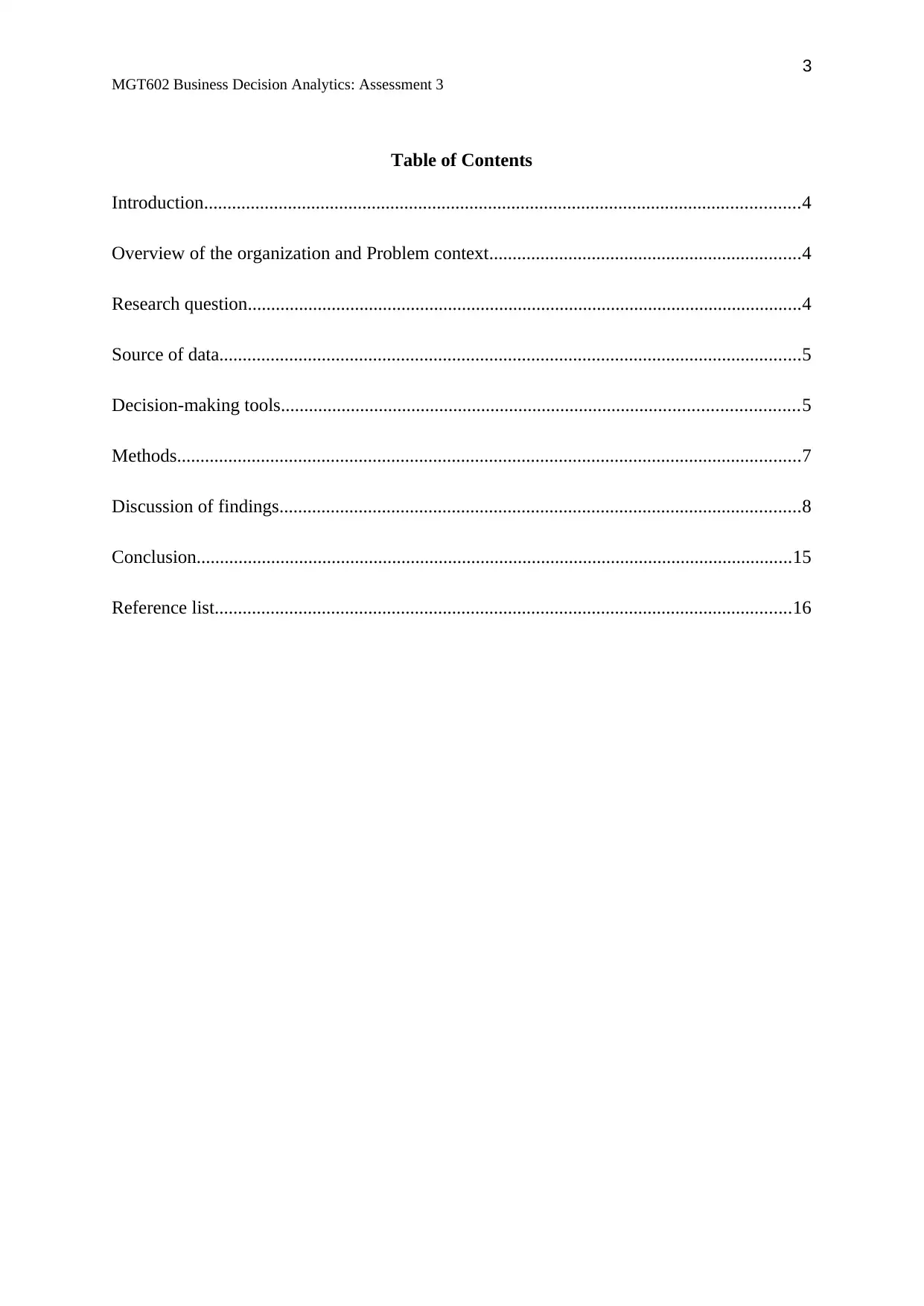
3
MGT602 Business Decision Analytics: Assessment 3
Table of Contents
Introduction................................................................................................................................4
Overview of the organization and Problem context...................................................................4
Research question.......................................................................................................................4
Source of data.............................................................................................................................5
Decision-making tools...............................................................................................................5
Methods......................................................................................................................................7
Discussion of findings................................................................................................................8
Conclusion................................................................................................................................15
Reference list............................................................................................................................16
MGT602 Business Decision Analytics: Assessment 3
Table of Contents
Introduction................................................................................................................................4
Overview of the organization and Problem context...................................................................4
Research question.......................................................................................................................4
Source of data.............................................................................................................................5
Decision-making tools...............................................................................................................5
Methods......................................................................................................................................7
Discussion of findings................................................................................................................8
Conclusion................................................................................................................................15
Reference list............................................................................................................................16
⊘ This is a preview!⊘
Do you want full access?
Subscribe today to unlock all pages.

Trusted by 1+ million students worldwide
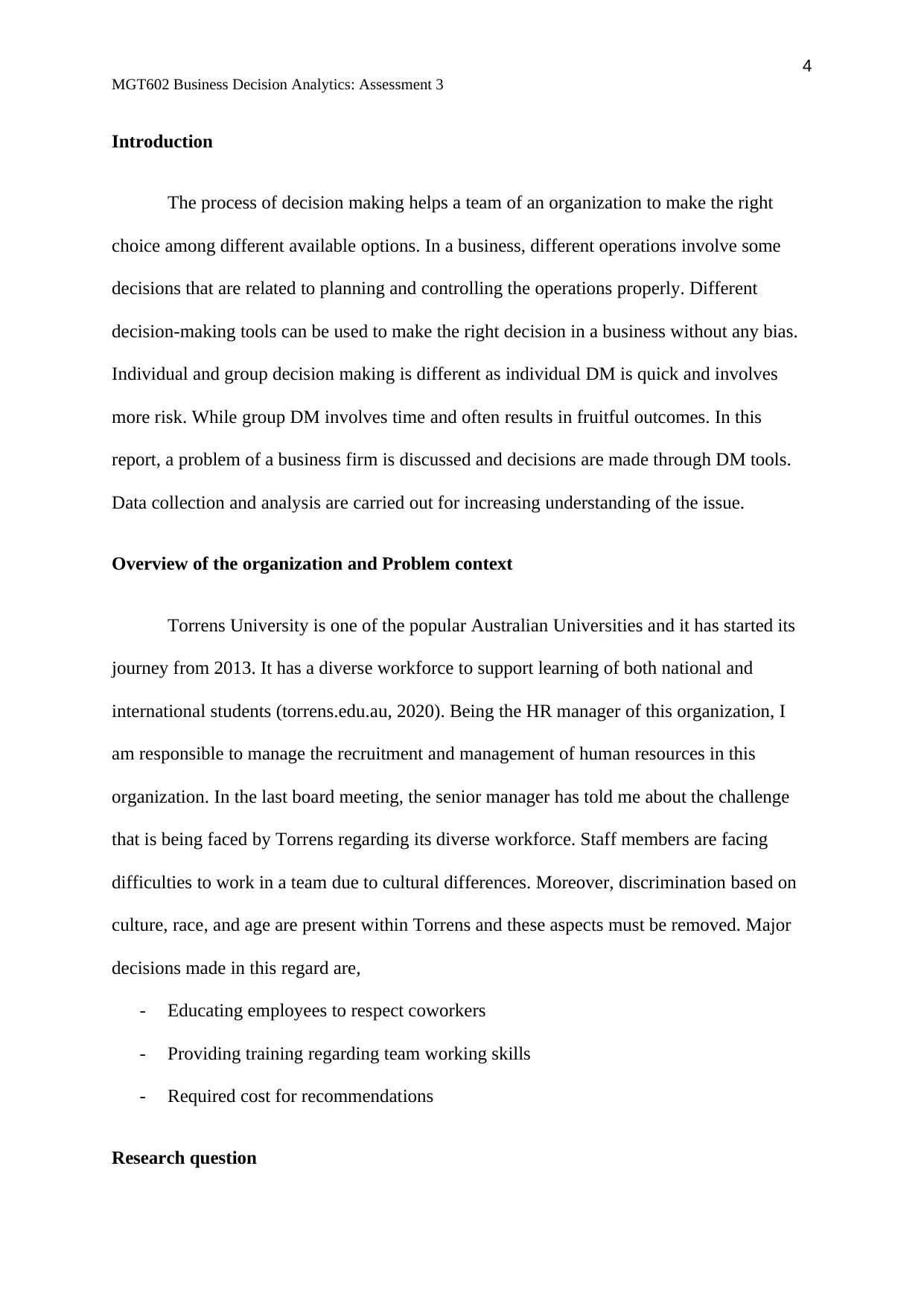
4
MGT602 Business Decision Analytics: Assessment 3
Introduction
The process of decision making helps a team of an organization to make the right
choice among different available options. In a business, different operations involve some
decisions that are related to planning and controlling the operations properly. Different
decision-making tools can be used to make the right decision in a business without any bias.
Individual and group decision making is different as individual DM is quick and involves
more risk. While group DM involves time and often results in fruitful outcomes. In this
report, a problem of a business firm is discussed and decisions are made through DM tools.
Data collection and analysis are carried out for increasing understanding of the issue.
Overview of the organization and Problem context
Torrens University is one of the popular Australian Universities and it has started its
journey from 2013. It has a diverse workforce to support learning of both national and
international students (torrens.edu.au, 2020). Being the HR manager of this organization, I
am responsible to manage the recruitment and management of human resources in this
organization. In the last board meeting, the senior manager has told me about the challenge
that is being faced by Torrens regarding its diverse workforce. Staff members are facing
difficulties to work in a team due to cultural differences. Moreover, discrimination based on
culture, race, and age are present within Torrens and these aspects must be removed. Major
decisions made in this regard are,
- Educating employees to respect coworkers
- Providing training regarding team working skills
- Required cost for recommendations
Research question
MGT602 Business Decision Analytics: Assessment 3
Introduction
The process of decision making helps a team of an organization to make the right
choice among different available options. In a business, different operations involve some
decisions that are related to planning and controlling the operations properly. Different
decision-making tools can be used to make the right decision in a business without any bias.
Individual and group decision making is different as individual DM is quick and involves
more risk. While group DM involves time and often results in fruitful outcomes. In this
report, a problem of a business firm is discussed and decisions are made through DM tools.
Data collection and analysis are carried out for increasing understanding of the issue.
Overview of the organization and Problem context
Torrens University is one of the popular Australian Universities and it has started its
journey from 2013. It has a diverse workforce to support learning of both national and
international students (torrens.edu.au, 2020). Being the HR manager of this organization, I
am responsible to manage the recruitment and management of human resources in this
organization. In the last board meeting, the senior manager has told me about the challenge
that is being faced by Torrens regarding its diverse workforce. Staff members are facing
difficulties to work in a team due to cultural differences. Moreover, discrimination based on
culture, race, and age are present within Torrens and these aspects must be removed. Major
decisions made in this regard are,
- Educating employees to respect coworkers
- Providing training regarding team working skills
- Required cost for recommendations
Research question
Paraphrase This Document
Need a fresh take? Get an instant paraphrase of this document with our AI Paraphraser
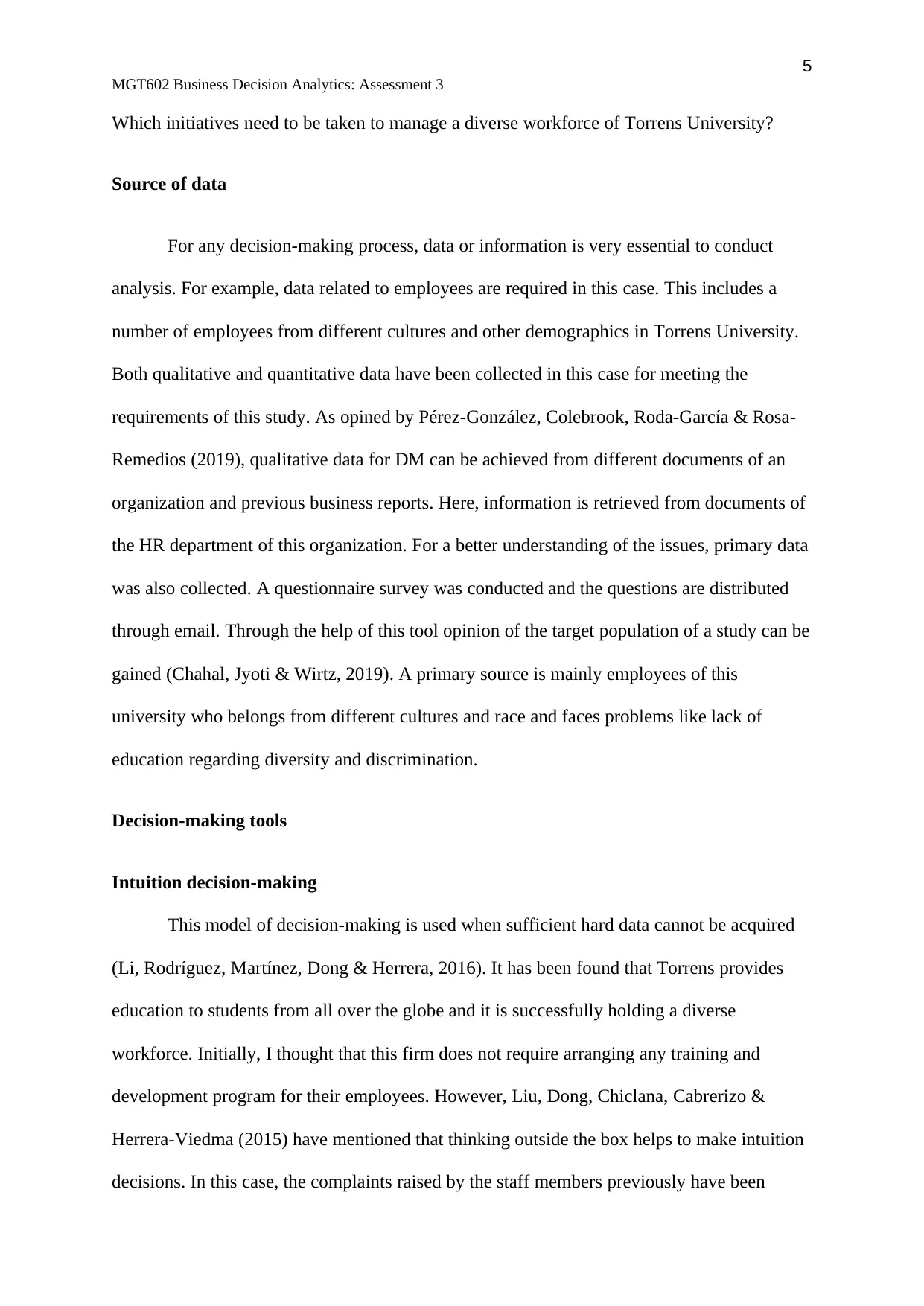
5
MGT602 Business Decision Analytics: Assessment 3
Which initiatives need to be taken to manage a diverse workforce of Torrens University?
Source of data
For any decision-making process, data or information is very essential to conduct
analysis. For example, data related to employees are required in this case. This includes a
number of employees from different cultures and other demographics in Torrens University.
Both qualitative and quantitative data have been collected in this case for meeting the
requirements of this study. As opined by Pérez-González, Colebrook, Roda-García & Rosa-
Remedios (2019), qualitative data for DM can be achieved from different documents of an
organization and previous business reports. Here, information is retrieved from documents of
the HR department of this organization. For a better understanding of the issues, primary data
was also collected. A questionnaire survey was conducted and the questions are distributed
through email. Through the help of this tool opinion of the target population of a study can be
gained (Chahal, Jyoti & Wirtz, 2019). A primary source is mainly employees of this
university who belongs from different cultures and race and faces problems like lack of
education regarding diversity and discrimination.
Decision-making tools
Intuition decision-making
This model of decision-making is used when sufficient hard data cannot be acquired
(Li, Rodríguez, Martínez, Dong & Herrera, 2016). It has been found that Torrens provides
education to students from all over the globe and it is successfully holding a diverse
workforce. Initially, I thought that this firm does not require arranging any training and
development program for their employees. However, Liu, Dong, Chiclana, Cabrerizo &
Herrera-Viedma (2015) have mentioned that thinking outside the box helps to make intuition
decisions. In this case, the complaints raised by the staff members previously have been
MGT602 Business Decision Analytics: Assessment 3
Which initiatives need to be taken to manage a diverse workforce of Torrens University?
Source of data
For any decision-making process, data or information is very essential to conduct
analysis. For example, data related to employees are required in this case. This includes a
number of employees from different cultures and other demographics in Torrens University.
Both qualitative and quantitative data have been collected in this case for meeting the
requirements of this study. As opined by Pérez-González, Colebrook, Roda-García & Rosa-
Remedios (2019), qualitative data for DM can be achieved from different documents of an
organization and previous business reports. Here, information is retrieved from documents of
the HR department of this organization. For a better understanding of the issues, primary data
was also collected. A questionnaire survey was conducted and the questions are distributed
through email. Through the help of this tool opinion of the target population of a study can be
gained (Chahal, Jyoti & Wirtz, 2019). A primary source is mainly employees of this
university who belongs from different cultures and race and faces problems like lack of
education regarding diversity and discrimination.
Decision-making tools
Intuition decision-making
This model of decision-making is used when sufficient hard data cannot be acquired
(Li, Rodríguez, Martínez, Dong & Herrera, 2016). It has been found that Torrens provides
education to students from all over the globe and it is successfully holding a diverse
workforce. Initially, I thought that this firm does not require arranging any training and
development program for their employees. However, Liu, Dong, Chiclana, Cabrerizo &
Herrera-Viedma (2015) have mentioned that thinking outside the box helps to make intuition
decisions. In this case, the complaints raised by the staff members previously have been
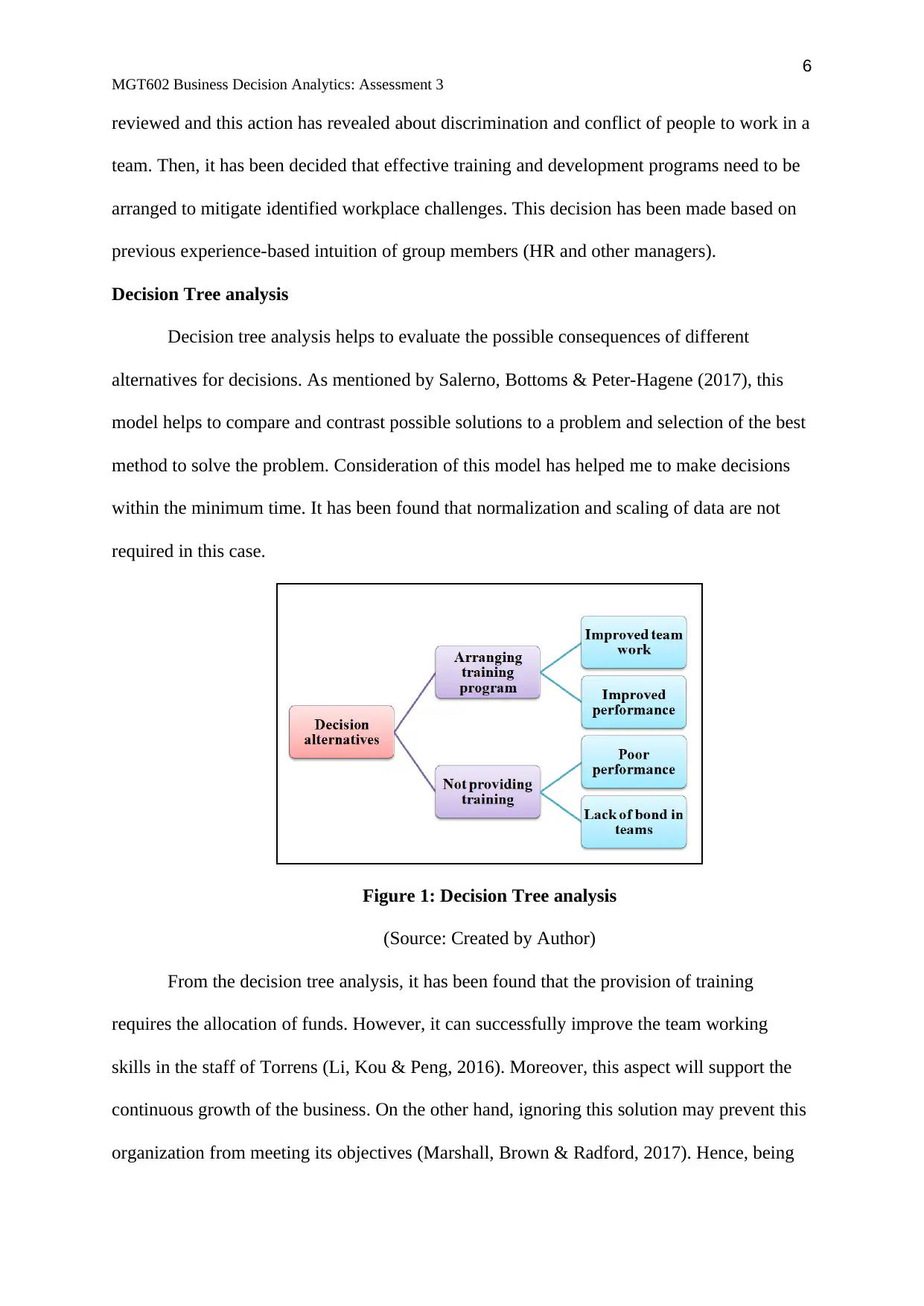
6
MGT602 Business Decision Analytics: Assessment 3
reviewed and this action has revealed about discrimination and conflict of people to work in a
team. Then, it has been decided that effective training and development programs need to be
arranged to mitigate identified workplace challenges. This decision has been made based on
previous experience-based intuition of group members (HR and other managers).
Decision Tree analysis
Decision tree analysis helps to evaluate the possible consequences of different
alternatives for decisions. As mentioned by Salerno, Bottoms & Peter-Hagene (2017), this
model helps to compare and contrast possible solutions to a problem and selection of the best
method to solve the problem. Consideration of this model has helped me to make decisions
within the minimum time. It has been found that normalization and scaling of data are not
required in this case.
Figure 1: Decision Tree analysis
(Source: Created by Author)
From the decision tree analysis, it has been found that the provision of training
requires the allocation of funds. However, it can successfully improve the team working
skills in the staff of Torrens (Li, Kou & Peng, 2016). Moreover, this aspect will support the
continuous growth of the business. On the other hand, ignoring this solution may prevent this
organization from meeting its objectives (Marshall, Brown & Radford, 2017). Hence, being
MGT602 Business Decision Analytics: Assessment 3
reviewed and this action has revealed about discrimination and conflict of people to work in a
team. Then, it has been decided that effective training and development programs need to be
arranged to mitigate identified workplace challenges. This decision has been made based on
previous experience-based intuition of group members (HR and other managers).
Decision Tree analysis
Decision tree analysis helps to evaluate the possible consequences of different
alternatives for decisions. As mentioned by Salerno, Bottoms & Peter-Hagene (2017), this
model helps to compare and contrast possible solutions to a problem and selection of the best
method to solve the problem. Consideration of this model has helped me to make decisions
within the minimum time. It has been found that normalization and scaling of data are not
required in this case.
Figure 1: Decision Tree analysis
(Source: Created by Author)
From the decision tree analysis, it has been found that the provision of training
requires the allocation of funds. However, it can successfully improve the team working
skills in the staff of Torrens (Li, Kou & Peng, 2016). Moreover, this aspect will support the
continuous growth of the business. On the other hand, ignoring this solution may prevent this
organization from meeting its objectives (Marshall, Brown & Radford, 2017). Hence, being
⊘ This is a preview!⊘
Do you want full access?
Subscribe today to unlock all pages.

Trusted by 1+ million students worldwide
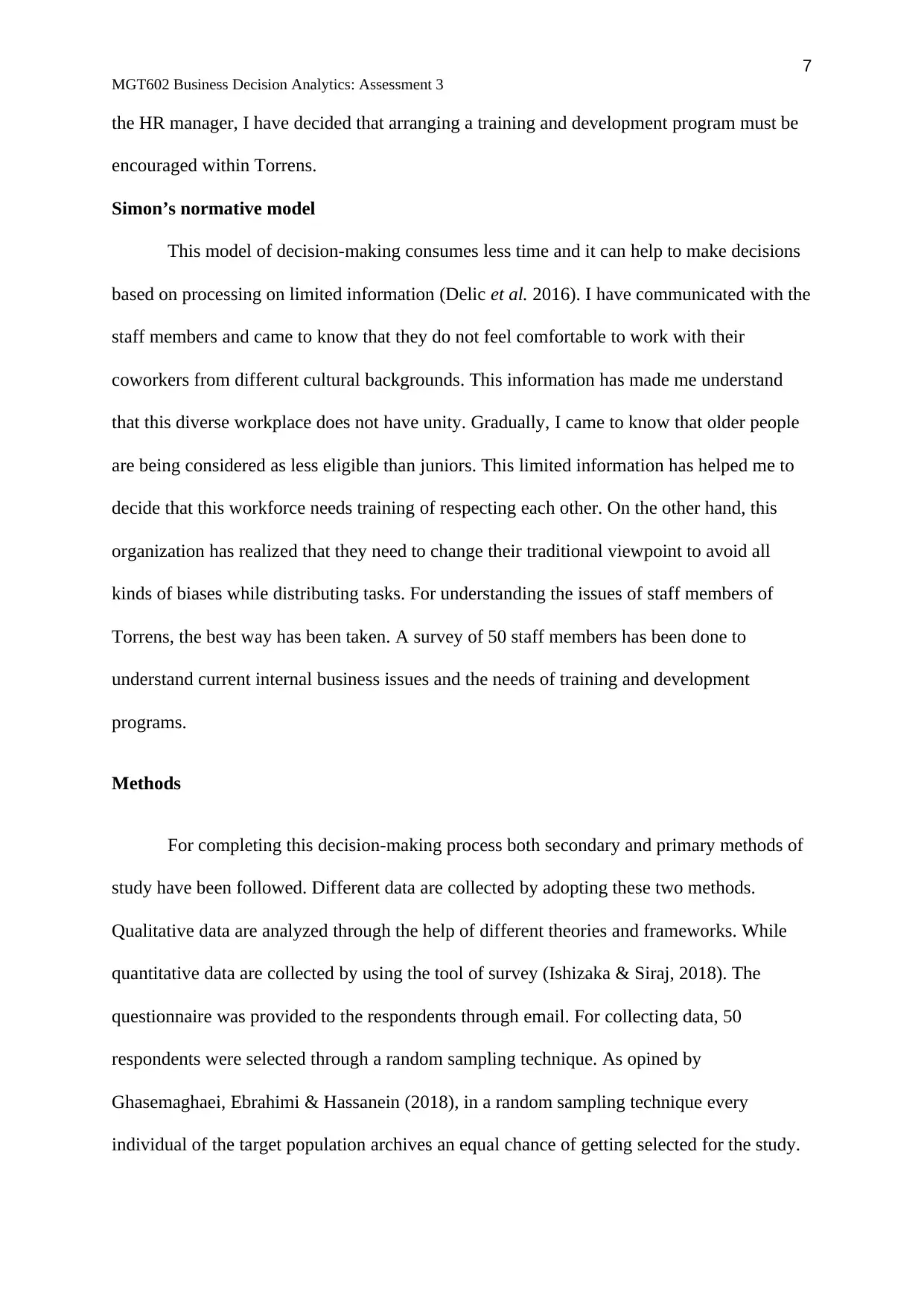
7
MGT602 Business Decision Analytics: Assessment 3
the HR manager, I have decided that arranging a training and development program must be
encouraged within Torrens.
Simon’s normative model
This model of decision-making consumes less time and it can help to make decisions
based on processing on limited information (Delic et al. 2016). I have communicated with the
staff members and came to know that they do not feel comfortable to work with their
coworkers from different cultural backgrounds. This information has made me understand
that this diverse workplace does not have unity. Gradually, I came to know that older people
are being considered as less eligible than juniors. This limited information has helped me to
decide that this workforce needs training of respecting each other. On the other hand, this
organization has realized that they need to change their traditional viewpoint to avoid all
kinds of biases while distributing tasks. For understanding the issues of staff members of
Torrens, the best way has been taken. A survey of 50 staff members has been done to
understand current internal business issues and the needs of training and development
programs.
Methods
For completing this decision-making process both secondary and primary methods of
study have been followed. Different data are collected by adopting these two methods.
Qualitative data are analyzed through the help of different theories and frameworks. While
quantitative data are collected by using the tool of survey (Ishizaka & Siraj, 2018). The
questionnaire was provided to the respondents through email. For collecting data, 50
respondents were selected through a random sampling technique. As opined by
Ghasemaghaei, Ebrahimi & Hassanein (2018), in a random sampling technique every
individual of the target population archives an equal chance of getting selected for the study.
MGT602 Business Decision Analytics: Assessment 3
the HR manager, I have decided that arranging a training and development program must be
encouraged within Torrens.
Simon’s normative model
This model of decision-making consumes less time and it can help to make decisions
based on processing on limited information (Delic et al. 2016). I have communicated with the
staff members and came to know that they do not feel comfortable to work with their
coworkers from different cultural backgrounds. This information has made me understand
that this diverse workplace does not have unity. Gradually, I came to know that older people
are being considered as less eligible than juniors. This limited information has helped me to
decide that this workforce needs training of respecting each other. On the other hand, this
organization has realized that they need to change their traditional viewpoint to avoid all
kinds of biases while distributing tasks. For understanding the issues of staff members of
Torrens, the best way has been taken. A survey of 50 staff members has been done to
understand current internal business issues and the needs of training and development
programs.
Methods
For completing this decision-making process both secondary and primary methods of
study have been followed. Different data are collected by adopting these two methods.
Qualitative data are analyzed through the help of different theories and frameworks. While
quantitative data are collected by using the tool of survey (Ishizaka & Siraj, 2018). The
questionnaire was provided to the respondents through email. For collecting data, 50
respondents were selected through a random sampling technique. As opined by
Ghasemaghaei, Ebrahimi & Hassanein (2018), in a random sampling technique every
individual of the target population archives an equal chance of getting selected for the study.
Paraphrase This Document
Need a fresh take? Get an instant paraphrase of this document with our AI Paraphraser
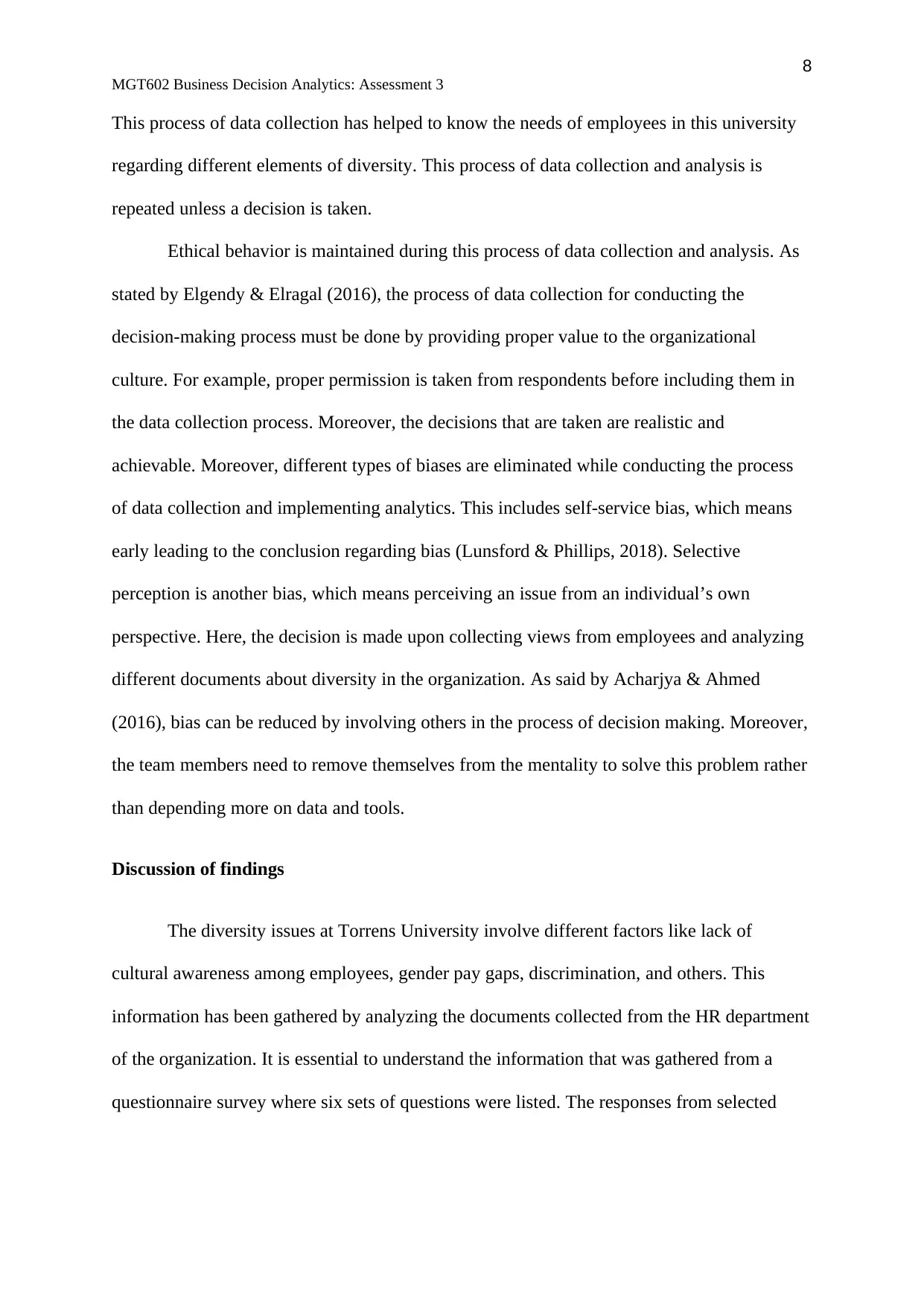
8
MGT602 Business Decision Analytics: Assessment 3
This process of data collection has helped to know the needs of employees in this university
regarding different elements of diversity. This process of data collection and analysis is
repeated unless a decision is taken.
Ethical behavior is maintained during this process of data collection and analysis. As
stated by Elgendy & Elragal (2016), the process of data collection for conducting the
decision-making process must be done by providing proper value to the organizational
culture. For example, proper permission is taken from respondents before including them in
the data collection process. Moreover, the decisions that are taken are realistic and
achievable. Moreover, different types of biases are eliminated while conducting the process
of data collection and implementing analytics. This includes self-service bias, which means
early leading to the conclusion regarding bias (Lunsford & Phillips, 2018). Selective
perception is another bias, which means perceiving an issue from an individual’s own
perspective. Here, the decision is made upon collecting views from employees and analyzing
different documents about diversity in the organization. As said by Acharjya & Ahmed
(2016), bias can be reduced by involving others in the process of decision making. Moreover,
the team members need to remove themselves from the mentality to solve this problem rather
than depending more on data and tools.
Discussion of findings
The diversity issues at Torrens University involve different factors like lack of
cultural awareness among employees, gender pay gaps, discrimination, and others. This
information has been gathered by analyzing the documents collected from the HR department
of the organization. It is essential to understand the information that was gathered from a
questionnaire survey where six sets of questions were listed. The responses from selected
MGT602 Business Decision Analytics: Assessment 3
This process of data collection has helped to know the needs of employees in this university
regarding different elements of diversity. This process of data collection and analysis is
repeated unless a decision is taken.
Ethical behavior is maintained during this process of data collection and analysis. As
stated by Elgendy & Elragal (2016), the process of data collection for conducting the
decision-making process must be done by providing proper value to the organizational
culture. For example, proper permission is taken from respondents before including them in
the data collection process. Moreover, the decisions that are taken are realistic and
achievable. Moreover, different types of biases are eliminated while conducting the process
of data collection and implementing analytics. This includes self-service bias, which means
early leading to the conclusion regarding bias (Lunsford & Phillips, 2018). Selective
perception is another bias, which means perceiving an issue from an individual’s own
perspective. Here, the decision is made upon collecting views from employees and analyzing
different documents about diversity in the organization. As said by Acharjya & Ahmed
(2016), bias can be reduced by involving others in the process of decision making. Moreover,
the team members need to remove themselves from the mentality to solve this problem rather
than depending more on data and tools.
Discussion of findings
The diversity issues at Torrens University involve different factors like lack of
cultural awareness among employees, gender pay gaps, discrimination, and others. This
information has been gathered by analyzing the documents collected from the HR department
of the organization. It is essential to understand the information that was gathered from a
questionnaire survey where six sets of questions were listed. The responses from selected
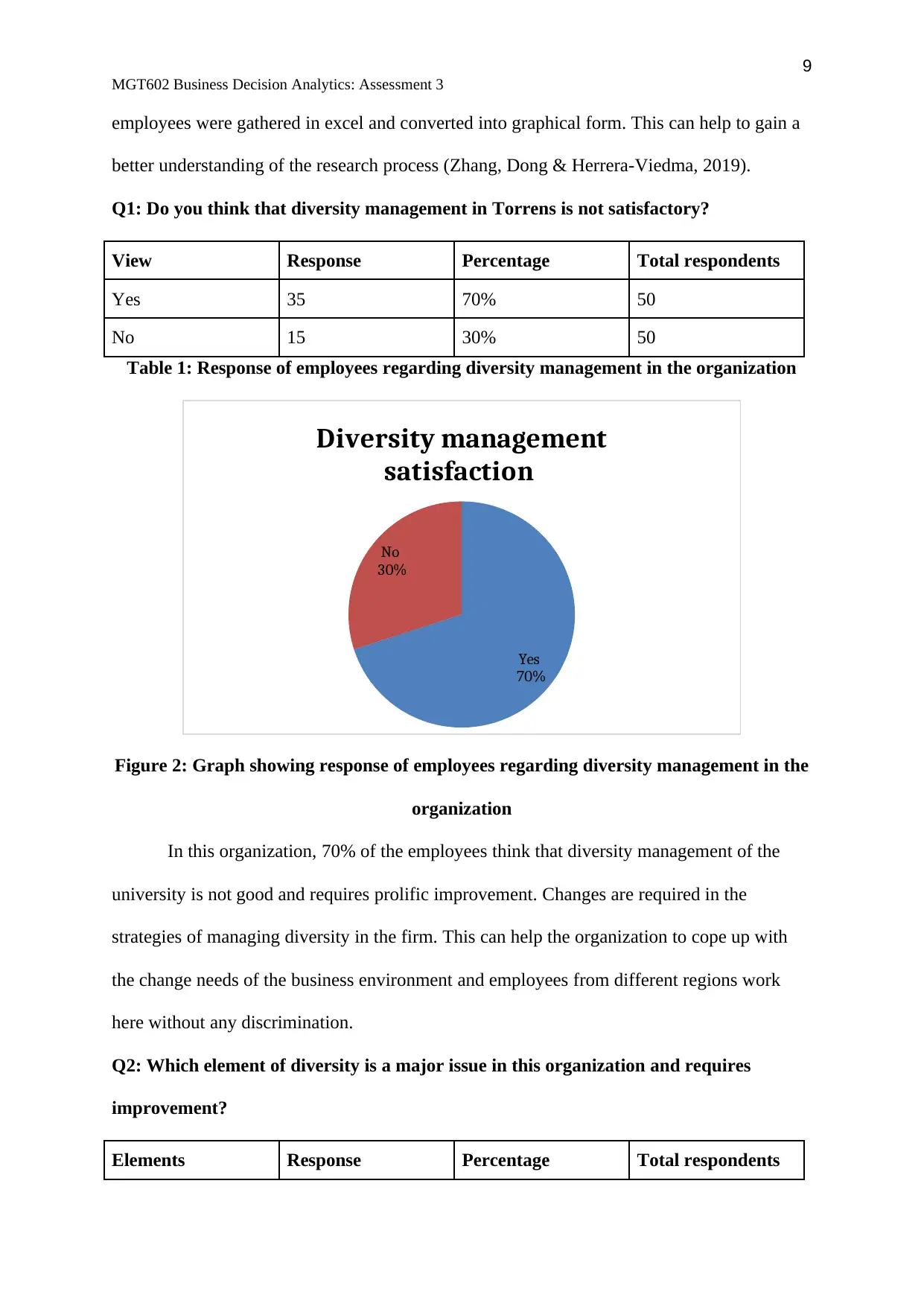
9
MGT602 Business Decision Analytics: Assessment 3
employees were gathered in excel and converted into graphical form. This can help to gain a
better understanding of the research process (Zhang, Dong & Herrera-Viedma, 2019).
Q1: Do you think that diversity management in Torrens is not satisfactory?
View Response Percentage Total respondents
Yes 35 70% 50
No 15 30% 50
Table 1: Response of employees regarding diversity management in the organization
Yes
70%
No
30%
Diversity management
satisfaction
Figure 2: Graph showing response of employees regarding diversity management in the
organization
In this organization, 70% of the employees think that diversity management of the
university is not good and requires prolific improvement. Changes are required in the
strategies of managing diversity in the firm. This can help the organization to cope up with
the change needs of the business environment and employees from different regions work
here without any discrimination.
Q2: Which element of diversity is a major issue in this organization and requires
improvement?
Elements Response Percentage Total respondents
MGT602 Business Decision Analytics: Assessment 3
employees were gathered in excel and converted into graphical form. This can help to gain a
better understanding of the research process (Zhang, Dong & Herrera-Viedma, 2019).
Q1: Do you think that diversity management in Torrens is not satisfactory?
View Response Percentage Total respondents
Yes 35 70% 50
No 15 30% 50
Table 1: Response of employees regarding diversity management in the organization
Yes
70%
No
30%
Diversity management
satisfaction
Figure 2: Graph showing response of employees regarding diversity management in the
organization
In this organization, 70% of the employees think that diversity management of the
university is not good and requires prolific improvement. Changes are required in the
strategies of managing diversity in the firm. This can help the organization to cope up with
the change needs of the business environment and employees from different regions work
here without any discrimination.
Q2: Which element of diversity is a major issue in this organization and requires
improvement?
Elements Response Percentage Total respondents
⊘ This is a preview!⊘
Do you want full access?
Subscribe today to unlock all pages.

Trusted by 1+ million students worldwide
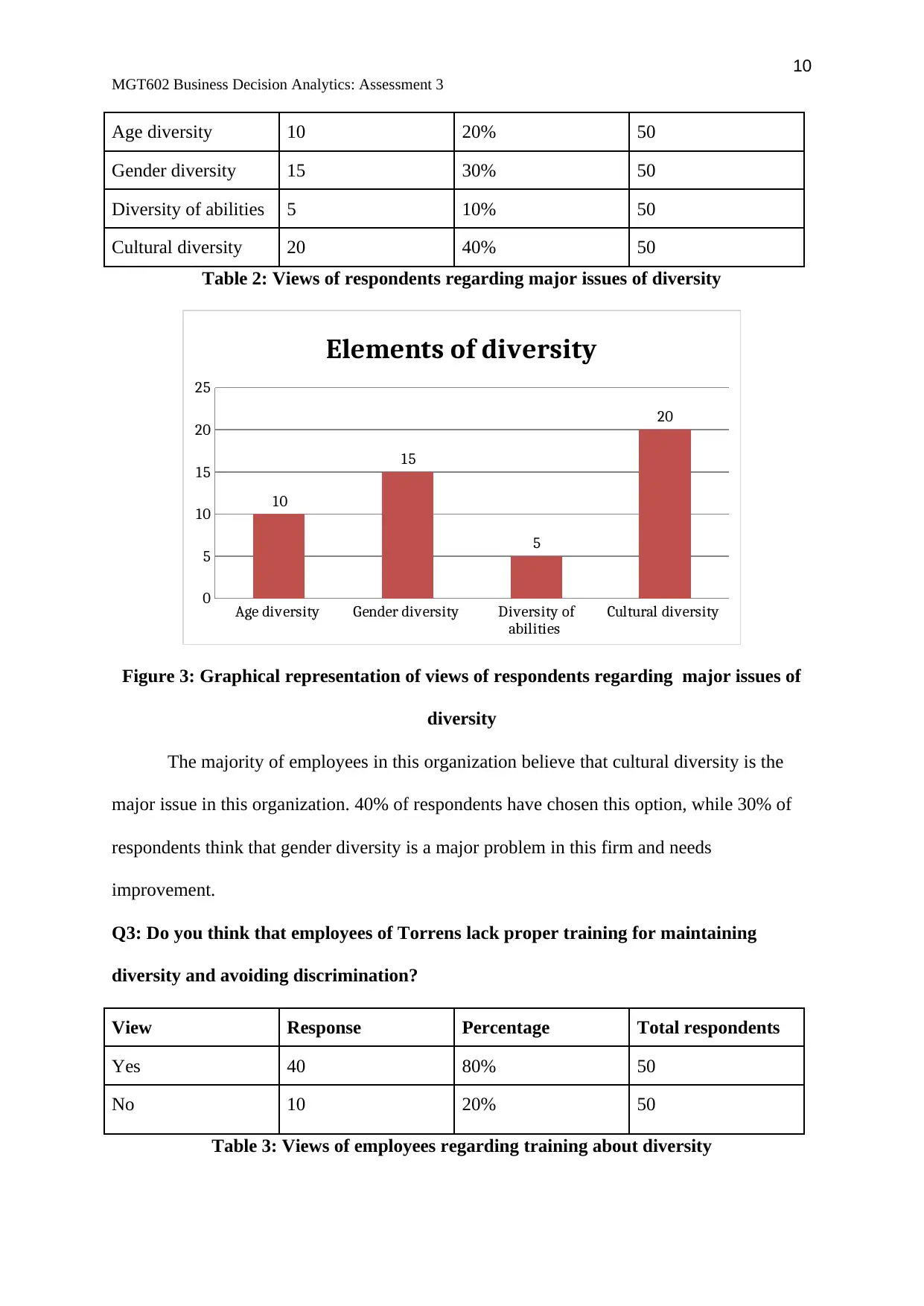
10
MGT602 Business Decision Analytics: Assessment 3
Age diversity 10 20% 50
Gender diversity 15 30% 50
Diversity of abilities 5 10% 50
Cultural diversity 20 40% 50
Table 2: Views of respondents regarding major issues of diversity
Age diversity Gender diversity Diversity of
abilities
Cultural diversity
0
5
10
15
20
25
10
15
5
20
Elements of diversity
Figure 3: Graphical representation of views of respondents regarding major issues of
diversity
The majority of employees in this organization believe that cultural diversity is the
major issue in this organization. 40% of respondents have chosen this option, while 30% of
respondents think that gender diversity is a major problem in this firm and needs
improvement.
Q3: Do you think that employees of Torrens lack proper training for maintaining
diversity and avoiding discrimination?
View Response Percentage Total respondents
Yes 40 80% 50
No 10 20% 50
Table 3: Views of employees regarding training about diversity
MGT602 Business Decision Analytics: Assessment 3
Age diversity 10 20% 50
Gender diversity 15 30% 50
Diversity of abilities 5 10% 50
Cultural diversity 20 40% 50
Table 2: Views of respondents regarding major issues of diversity
Age diversity Gender diversity Diversity of
abilities
Cultural diversity
0
5
10
15
20
25
10
15
5
20
Elements of diversity
Figure 3: Graphical representation of views of respondents regarding major issues of
diversity
The majority of employees in this organization believe that cultural diversity is the
major issue in this organization. 40% of respondents have chosen this option, while 30% of
respondents think that gender diversity is a major problem in this firm and needs
improvement.
Q3: Do you think that employees of Torrens lack proper training for maintaining
diversity and avoiding discrimination?
View Response Percentage Total respondents
Yes 40 80% 50
No 10 20% 50
Table 3: Views of employees regarding training about diversity
Paraphrase This Document
Need a fresh take? Get an instant paraphrase of this document with our AI Paraphraser
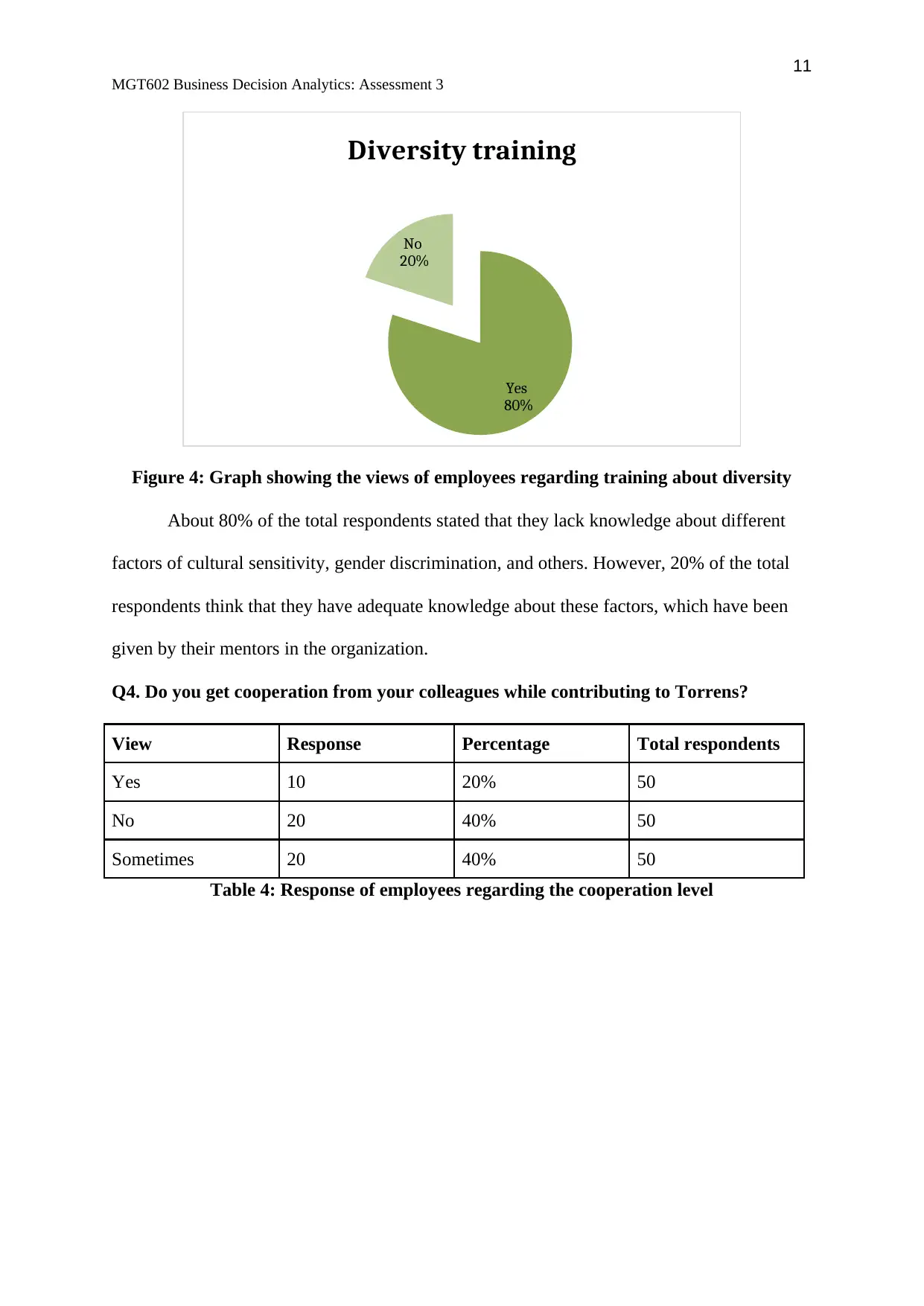
11
MGT602 Business Decision Analytics: Assessment 3
Yes
80%
No
20%
Diversity training
Figure 4: Graph showing the views of employees regarding training about diversity
About 80% of the total respondents stated that they lack knowledge about different
factors of cultural sensitivity, gender discrimination, and others. However, 20% of the total
respondents think that they have adequate knowledge about these factors, which have been
given by their mentors in the organization.
Q4. Do you get cooperation from your colleagues while contributing to Torrens?
View Response Percentage Total respondents
Yes 10 20% 50
No 20 40% 50
Sometimes 20 40% 50
Table 4: Response of employees regarding the cooperation level
MGT602 Business Decision Analytics: Assessment 3
Yes
80%
No
20%
Diversity training
Figure 4: Graph showing the views of employees regarding training about diversity
About 80% of the total respondents stated that they lack knowledge about different
factors of cultural sensitivity, gender discrimination, and others. However, 20% of the total
respondents think that they have adequate knowledge about these factors, which have been
given by their mentors in the organization.
Q4. Do you get cooperation from your colleagues while contributing to Torrens?
View Response Percentage Total respondents
Yes 10 20% 50
No 20 40% 50
Sometimes 20 40% 50
Table 4: Response of employees regarding the cooperation level
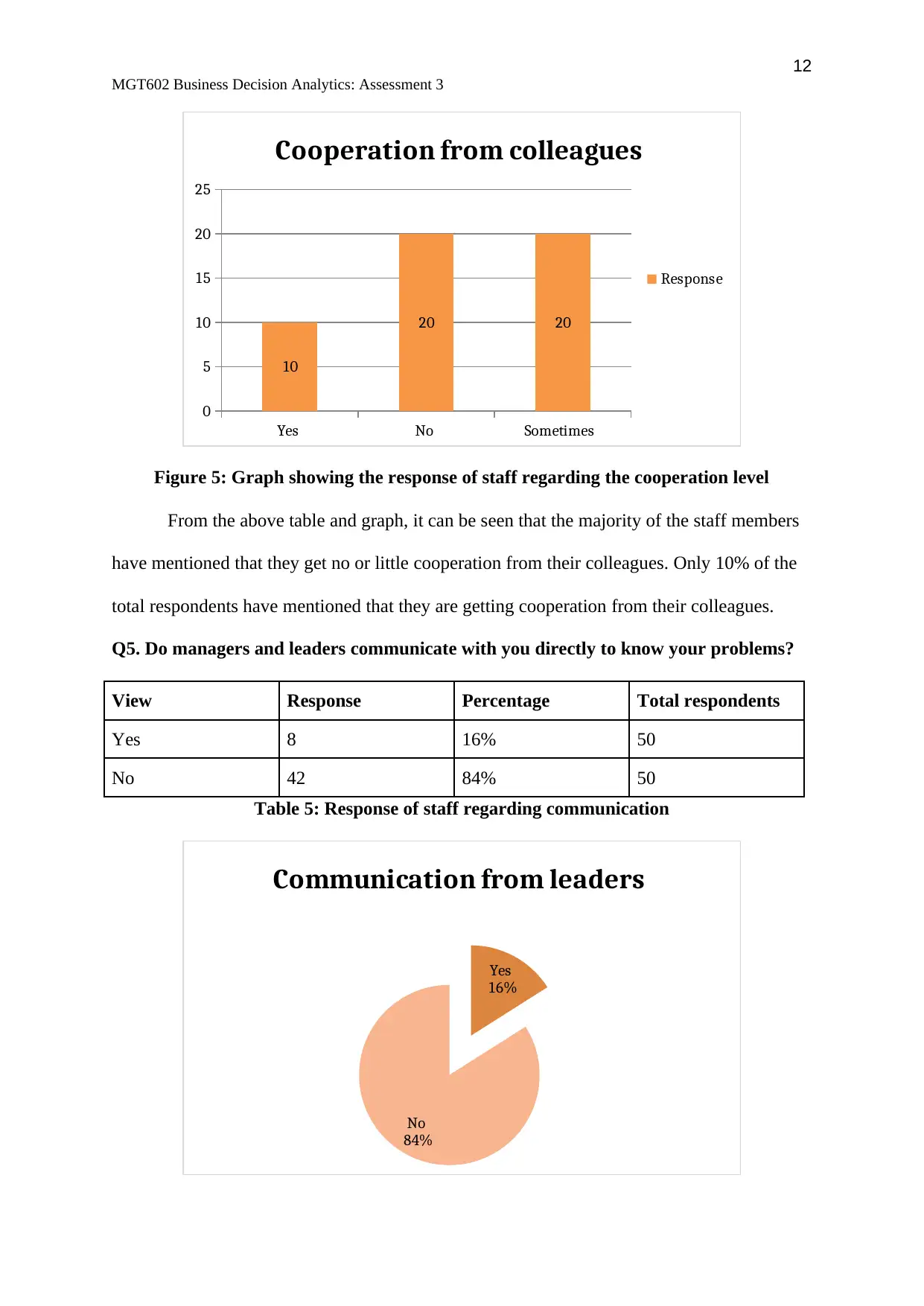
12
MGT602 Business Decision Analytics: Assessment 3
Yes No Sometimes
0
5
10
15
20
25
10
20 20
Cooperation from colleagues
Response
Figure 5: Graph showing the response of staff regarding the cooperation level
From the above table and graph, it can be seen that the majority of the staff members
have mentioned that they get no or little cooperation from their colleagues. Only 10% of the
total respondents have mentioned that they are getting cooperation from their colleagues.
Q5. Do managers and leaders communicate with you directly to know your problems?
View Response Percentage Total respondents
Yes 8 16% 50
No 42 84% 50
Table 5: Response of staff regarding communication
Yes
16%
No
84%
Communication from leaders
MGT602 Business Decision Analytics: Assessment 3
Yes No Sometimes
0
5
10
15
20
25
10
20 20
Cooperation from colleagues
Response
Figure 5: Graph showing the response of staff regarding the cooperation level
From the above table and graph, it can be seen that the majority of the staff members
have mentioned that they get no or little cooperation from their colleagues. Only 10% of the
total respondents have mentioned that they are getting cooperation from their colleagues.
Q5. Do managers and leaders communicate with you directly to know your problems?
View Response Percentage Total respondents
Yes 8 16% 50
No 42 84% 50
Table 5: Response of staff regarding communication
Yes
16%
No
84%
Communication from leaders
⊘ This is a preview!⊘
Do you want full access?
Subscribe today to unlock all pages.

Trusted by 1+ million students worldwide
1 out of 18
Related Documents
Your All-in-One AI-Powered Toolkit for Academic Success.
+13062052269
info@desklib.com
Available 24*7 on WhatsApp / Email
![[object Object]](/_next/static/media/star-bottom.7253800d.svg)
Unlock your academic potential
Copyright © 2020–2025 A2Z Services. All Rights Reserved. Developed and managed by ZUCOL.





